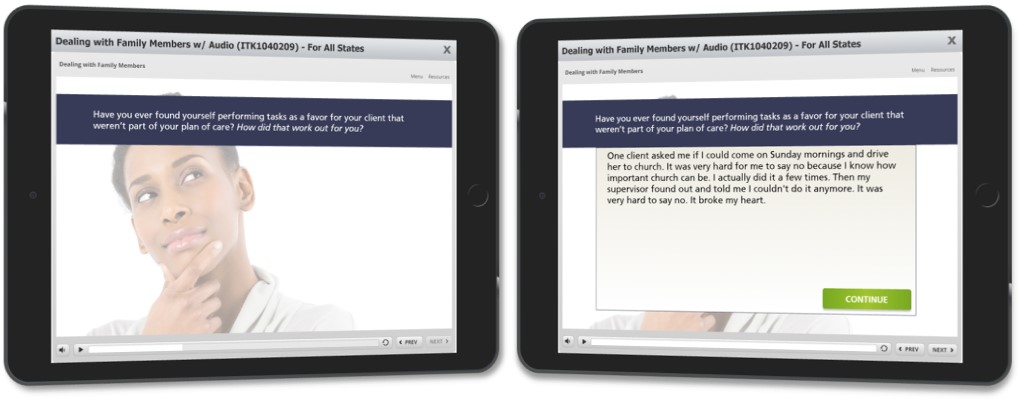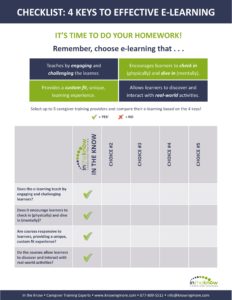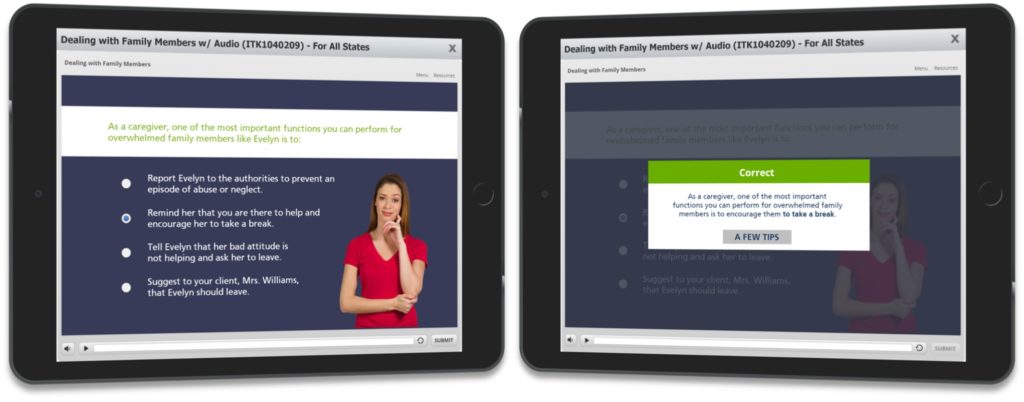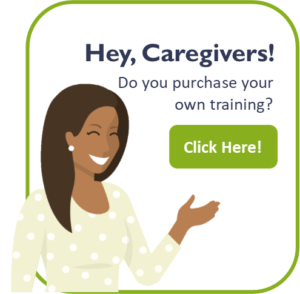Choosing the right e-learning provider for the caregivers in your organization is a vital task. It requires a significant commitment in both time and resources. Of course, we want you to choose intheknow, but we also know you must do your homework! It’s smart to shop around. You have a big decision to make!
But how do you know you’re making the right choice? How do you determine if a product is high-quality and will be effective for your caregivers?
 We went straight to the source to find you the answers!
We went straight to the source to find you the answers!
Delaney Collyer is a professional Instructional Designer and E-Learning Course Developer. She has keen insight into how important it is for e-learning to be interactive, engaging—and frankly—fun!
She took time out of her busy schedule to help us drill down to the four most important features of effective e-learning.
Here’s what Delaney told us:
I hate to be negative, but I think it’s important to start with what you should AVOID when choosing an e-learning provider. E-learning is fairly new to the aging care market. And, like most shiny, new things, plenty of opportunity seekers jumped on the bandwagon to cash in. But, many of these bandwagon riders fall right into the ditch with a few common errors that decrease both the quality and effectiveness of their e-learning.
What e-learning should NOT look like:
- Teaching by telling. Simply dumping words onto a slide and expecting the learner to absorb, make sense, and remember it is an approach that may be convenient for an e-learning provider. It allows them to develop a lot of courses in a short time. But this method is a serious disservice to the learners on your team.
- Check in (physically) and check out (mentally). Video based, auto-play courses that score only on attendance are too passive. The learner’s attention (and maybe even their bodies) will be far away from the course that is playing on their screen!
- One size fits all. E-learning that fails to create a personalized experience leaves learners without key skill-building opportunities. As a result, the learner cannot retain or transfer the knowledge to on-the-job performance.
- Lack of real-world activities. E-learning activities that lack a real-world focus merely present information and quiz learners on rote facts. Learners are left wondering, “Why should I care about this information?”
What E-Learning SHOULD Look Like:
Okay, enough with the negative. Take a look at four factors that make e-learning engaging and effective. This is what e-learning SHOULD look like—and what you want for your learners.
1.Teaching by engaging. Teaching is not just about information delivery! Content and learning experiences should be carefully structured to engage and challenge learners. It should activate their prior knowledge and allow them to delve deeper into the topic. Cognitive preparation is key for learning and retention!
intheknow’s e-learning engages learners. Each course is filled with opportunities that encourage learners to meld new knowledge with what they already know. First, learners begin each course with a scenario or question that activates prior knowledge. As the course continues, they share their own experiences and elaborate on current knowledge. Finally, they use their new knowledge to complete meaningful activities.
2. Check in (physically) and dive in (mentally). E-learning—just like any kind of learning—should not be a passive activity. High-quality e-learning creates active learners who stay checked-in and focused throughout the course.
At intheknow, courses are built to draw caregivers in. Giving learners multiple ways to take in information, share their own thoughts, and check their memories for information, helps them build new knowledge every step of the way.
 3. Custom fit. Every learner is unique. The best learning experiences will ‘meet them where they are.’ Learning research finds that prompt, customized feedback is key to effective practice and learning.
3. Custom fit. Every learner is unique. The best learning experiences will ‘meet them where they are.’ Learning research finds that prompt, customized feedback is key to effective practice and learning.
E-learning at intheknow personalizes your caregivers’ experiences! While learners work through mini-quizzes and practice activities, they receive immediate, relevant feedback to guide and scaffold their learning.
4. Real-world activities. Learning activities need to be relevant and transferable to real-world scenarios. When learners recognize the relevance of new information, they are more likely to use it in the workplace.
intheknow’s e-learning courses present your caregivers with case-based scenarios that are authentic to what they actually encounter in their day to day work with clients. They are given the opportunity to apply their new knowledge by responding to real life scenarios. As a result, caregivers are prepared and motivated to take their new knowledge directly into the care environment.
What’s Next? It’s time to do your homework!
Fill out the form below to download our new worksheet to help guide your decision-making process.

[wpforms id=”5055″]
And, be sure to schedule a demo with one of our
Caregiver Training Advisors so you can see for yourself how we
apply the 4 Keys to Effective E-Learning in our courses!



